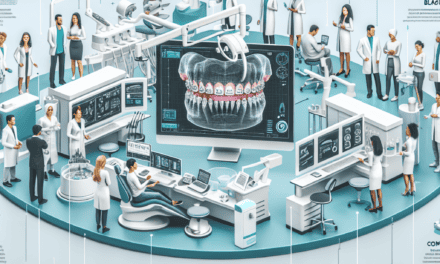Revolutionizing Eye Care: EHNOTE at ASCRS-ASOA 2025 with Ophthalmology 2.0
The field of ophthalmology is undergoing a significant transformation, driven by technological advancements and innovative practices. At the forefront of this revolution is EHNOTE, a pioneering platform that aims to enhance eye care through the integration of digital health solutions. The upcoming ASCRS-ASOA 2025 conference serves as a pivotal moment for EHNOTE to showcase its contributions to what is being termed “Ophthalmology 2.0.” This article delves into the various aspects of this transformation, exploring how EHNOTE is set to revolutionize eye care through advanced technologies, patient engagement, data analytics, and collaborative practices.
1. Understanding Ophthalmology 2.0
Ophthalmology 2.0 represents a paradigm shift in eye care, characterized by the integration of digital technologies, patient-centered approaches, and data-driven decision-making. This new era aims to improve patient outcomes, streamline clinical workflows, and enhance the overall experience of both patients and healthcare providers.
Key components of Ophthalmology 2.0 include:
- Telemedicine: The rise of telehealth services allows for remote consultations, making eye care more accessible.
- Artificial Intelligence (AI): AI algorithms are being developed to assist in diagnosing eye conditions and predicting treatment outcomes.
- Patient Engagement Tools: Digital platforms that facilitate communication between patients and providers, enhancing adherence to treatment plans.
- Data Analytics: Leveraging big data to improve clinical decision-making and personalize patient care.
- Collaborative Care Models: Encouraging interdisciplinary approaches to eye care, integrating various specialties for comprehensive treatment.
As we explore the role of EHNOTE in this transformation, it is essential to understand how these components interact to create a more efficient and effective eye care system.
2. EHNOTE: A Game Changer in Eye Care
EHNOTE is an innovative platform designed to enhance the delivery of eye care services. By leveraging cutting-edge technology, EHNOTE aims to address some of the most pressing challenges faced by ophthalmologists and their patients. The platform offers a suite of tools that streamline clinical workflows, improve patient engagement, and facilitate data sharing among healthcare providers.
Some of the key features of EHNOTE include:
- Integrated Electronic Health Records (EHR): EHNOTE provides a comprehensive EHR system tailored specifically for ophthalmology, allowing for seamless documentation and retrieval of patient information.
- Telehealth Capabilities: The platform supports virtual consultations, enabling ophthalmologists to reach patients in remote areas and those with mobility challenges.
- Patient Education Resources: EHNOTE offers a library of educational materials that empower patients to understand their conditions and treatment options better.
- Data Analytics Tools: The platform includes analytics features that help providers track patient outcomes and identify trends in treatment efficacy.
- Collaboration Features: EHNOTE facilitates communication among healthcare providers, allowing for coordinated care and shared decision-making.
By addressing the unique needs of ophthalmology, EHNOTE positions itself as a vital tool for practitioners looking to enhance their practice and improve patient care. The platform’s user-friendly interface and robust functionality make it an attractive option for eye care professionals.
3. Enhancing Patient Engagement through Technology
One of the most significant challenges in healthcare is ensuring that patients are engaged in their care. EHNOTE addresses this issue by providing tools that foster communication and education. Engaged patients are more likely to adhere to treatment plans, attend follow-up appointments, and report better health outcomes.
Key strategies employed by EHNOTE to enhance patient engagement include:
- Personalized Communication: EHNOTE allows providers to send tailored messages to patients, reminding them of appointments, medication schedules, and lifestyle changes.
- Educational Content: The platform offers a wealth of resources, including videos, articles, and infographics, to help patients understand their conditions and treatment options.
- Patient Portals: EHNOTE features secure patient portals where individuals can access their health records, lab results, and educational materials at any time.
- Feedback Mechanisms: The platform encourages patients to provide feedback on their experiences, allowing providers to make necessary adjustments to improve care.
- Support Communities: EHNOTE fosters online communities where patients can connect with others facing similar challenges, providing emotional support and shared experiences.
By implementing these strategies, EHNOTE not only enhances patient engagement but also empowers individuals to take an active role in their eye care journey. This shift towards patient-centered care is a hallmark of Ophthalmology 2.0.
4. The Role of Data Analytics in Eye Care
Data analytics is revolutionizing healthcare by enabling providers to make informed decisions based on real-time data. In ophthalmology, the ability to analyze patient data can lead to improved diagnosis, treatment planning, and outcome tracking. EHNOTE harnesses the power of data analytics to enhance the quality of eye care.
Key applications of data analytics in EHNOTE include:
- Predictive Analytics: By analyzing historical patient data, EHNOTE can identify trends and predict potential complications, allowing for proactive interventions.
- Outcome Measurement: The platform enables providers to track treatment outcomes over time, helping to refine protocols and improve patient care.
- Population Health Management: EHNOTE aggregates data across patient populations, allowing for the identification of at-risk groups and targeted interventions.
- Clinical Research: The data collected through EHNOTE can be utilized for clinical research, contributing to the advancement of ophthalmic knowledge and practices.
- Quality Improvement Initiatives: By analyzing performance metrics, providers can identify areas for improvement and implement strategies to enhance care delivery.
The integration of data analytics into eye care not only improves individual patient outcomes but also contributes to the overall advancement of the field. As more ophthalmologists adopt EHNOTE, the potential for data-driven insights will continue to grow, leading to better care for all patients.
5. Collaborative Care Models in Ophthalmology
Collaboration among healthcare providers is essential for delivering comprehensive care, especially in complex fields like ophthalmology. EHNOTE promotes collaborative care models that integrate various specialties, ensuring that patients receive holistic treatment tailored to their needs.
Key aspects of collaborative care facilitated by EHNOTE include:
- Interdisciplinary Teams: EHNOTE encourages the formation of teams that include ophthalmologists, optometrists, primary care physicians, and other specialists to address all aspects of a patient’s eye health.
- Shared Care Plans: The platform allows for the creation of shared care plans that all providers can access, ensuring everyone is on the same page regarding a patient’s treatment.
- Referral Management: EHNOTE streamlines the referral process, making it easier for providers to refer patients to specialists and track their progress.
- Continuity of Care: By facilitating communication among providers, EHNOTE ensures that patients receive consistent care throughout their treatment journey.
- Patient-Centered Approach: Collaborative care models prioritize the patient’s needs and preferences, leading to more personalized and effective treatment.
The shift towards collaborative care in ophthalmology is a critical component of Ophthalmology 2.0. By leveraging EHNOTE’s capabilities, healthcare providers can work together more effectively, ultimately improving patient outcomes and satisfaction.
Conclusion
The future of eye care is bright, thanks to innovative platforms like EHNOTE that are leading the charge in the Ophthalmology 2.0 movement. By integrating technology, enhancing patient engagement, utilizing data analytics, and promoting collaborative care models, EHNOTE is revolutionizing the way eye care is delivered. As we look forward to the ASCRS-ASOA 2025 conference, it is clear that the advancements showcased by EHNOTE will play a crucial role in shaping the future of ophthalmology.
In summary, the key takeaways from this exploration of EHNOTE and Ophthalmology 2.0 include:
- The importance of integrating digital health solutions to enhance patient care.
- The role of patient engagement in improving treatment adherence and outcomes.
- The transformative power of data analytics in driving informed clinical decisions.
- The necessity of collaborative care models in providing comprehensive eye care.
- The potential for platforms like EHNOTE to lead the way in the evolution of ophthalmology.
As the field continues to evolve, it is essential for ophthalmologists and healthcare providers to embrace these changes and leverage the tools available to them. The future of eye care is not just about treating conditions; it is about creating a holistic, patient-centered experience that empowers individuals to take charge of their health.





